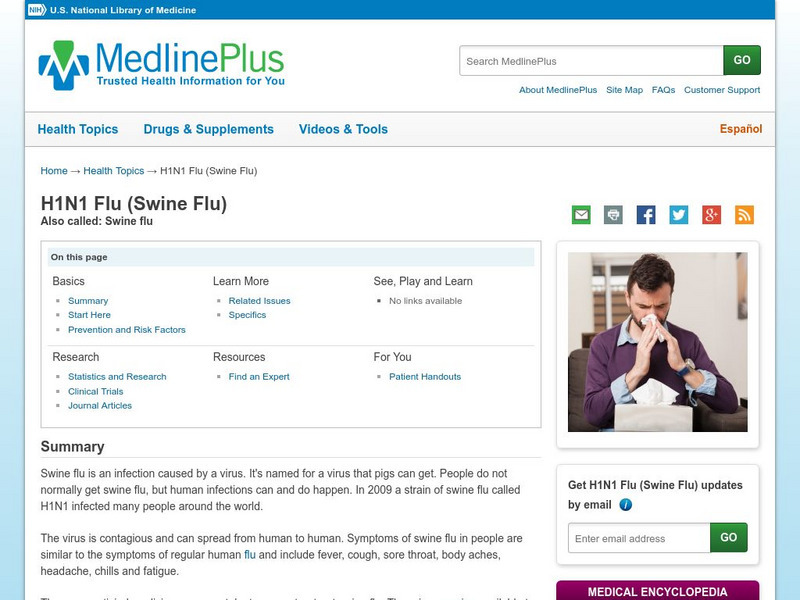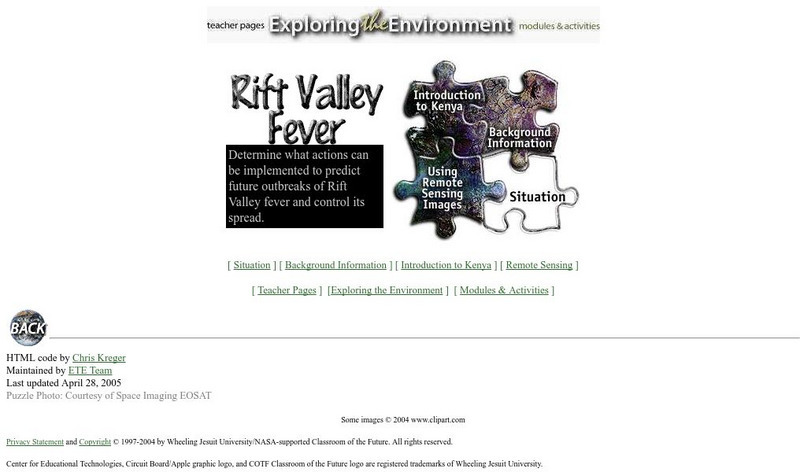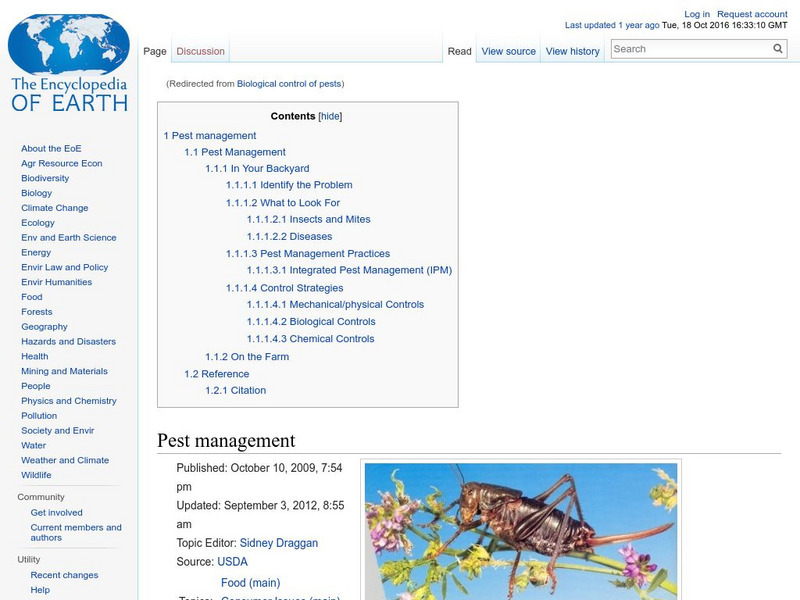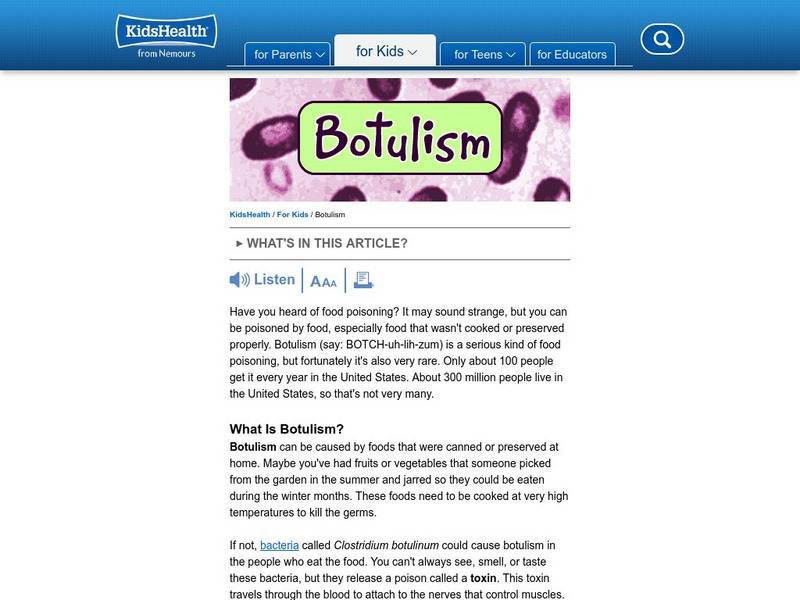US National Library of Medicine
Medline Plus: H1 N1 Flu (Swine Flu)
Brings together information from the National Library of Medicine, the National Institutes of Health, the Centers for Disease Control and Prevention, and other government agencies and health related organizations on H1N1 flu. Has videos...
Center for Educational Technologies
Nasa Classroom of the Future: Rift Valley Fever
The Classroom of the Future provides a nice activity integrating many subject areas. Students work in groups to research outbreaks of Rift Valley Fever in Kenya, and determine actions to control and prevent its spread. Background...
University of Missouri
Microbes in Action: Classroom Activities: Transfer of Diseases
A science experiment to observe how microbes are transferred by hand contact. This lab creates a model to show students how microbes transfer disease. One student will rub their hand with candy soaked in a yeast solution, then students...
Mayo Clinic
Mayo Clinic: Fitness
Why exercise? Information on the link between exercise and disease prevention, on how to begin an exercise program, on staying motivated, and on different ways to get fit.
Centers for Disease Control and Prevention
Centers for Disease Control: Get Smart: Know When Antibiotics Work
This particular site discusses the surge in drug-resistant bacteria, and what you can do to prevent one from using you as a petri dish.
Remedy Health Media
The Body: Survival of Hiv in the Environment
A good site which explains the effect of the outside the body environment on the HIV virus. This addresses the common fear of airborne transmission. Original resource from 1999 U. S. Center for Disease Control and Prevention.
Remedy Health Media
The Body: Rumors, Myths and Hoaxes About Hiv and Its Transmission
Very good debunking of a variety of misconceptions and myths about the HIV virus. Original resource from 2007 U. S. Center for Disease Control and Prevention.
Remedy Health Media
The Body: Human Immunodeficiency Virus Type 2
A very good summary of what we know about a second strain of HIV and its appearance in the population. Original resource from 2007 U. S. Center for Disease Control and Prevention.
University of Virginia
U of Virginia: Bad Blood: The Tuskegee Syphilis Study
Participants in the Tuskegee Syphilis Study were never told that they had syphilis. Instead, the doctors and scientists said they had "bad blood." Find out what took place during this study, and the social and political consequences...
PBS
Pbs: An Apology 65 Years Late
An article covering former President Clinton's apology to the survivors and family members of the Tuskegee Syphilis Study. Dated May 16, 2007.
US National Library of Medicine
Medline Plus: Cardiac Rehabilitation
This tutorial presents information about cardiac rehabilitation. Rehabilitation is necessary to maintain heart health. The heart, angina, exercise, prevention, obesity and other risk factors are covered.
Science Buddies
Science Buddies: Spread the Soap, Not the Germs
Washing your hands is the best way to prevent the spread of germs. But germs can be tricky; they find nooks and crannies to hide in, so it takes good hand-washing technique to get rid of them. This science project investigates which...
OpenSciEd
Open Ed Sci: Covid 19 & Health Equity, Grades K 2
In this unit, learners explore the basics of how Covid-19 affects people, and design investigations to explore how it spreads from person to person, and what we can do to prevent that spread.
Encyclopedia of Earth
Encyclopedia of Earth: Entomology: Pest Management
Article discussing the types of pests that can affect garden plants (insects, mites, disease, weeds), how to determine the problem, ways of dealing with it, and prevention strategies. It also looks briefly at pest management on a farm....
National Institutes of Health
Niddk: Heartburn, Hiatal Hernia, and Gastroesophageal Reflux
This resource presents information about how gastroesophageal reflux disease plays a major role in the cause of heartburn. A number of questions are asked and answered in this comprehensive and informative resource.
Other
Nsf International: Nsf Scrub Club
Keep yourself clean, kill bacteria, and stay healthy all year long by washing your hands (and under your fingernails) with warm soapy water. Play the "6 Steps Game" to learn how to properly clean your hands, meet the "villains" that...
Curated OER
Kids Health: Why Should I Care About Germs
Feeling stuffy? Running a fever? Well, read through this article and learn about the different types of germs and what you can do to prevent them. Don't miss the link that includes articles to similar sites.
Aetna Intelihealth
Aetna: Inteli Health: High Cholesterol
Thorough overview of high cholesterol. Includes information on symptoms, diagnosis, prevention, and much more.
Aetna Intelihealth
Aetna: Inteli Health: Heart Attack (Myocardial Infarction)
Thorough overview of heart attacks. Includes information on symptoms, treatment, prevention and much more.
Curated OER
Kids Health: Botulism
Keep yourself safe from botulism -- "a rare disease that affects nerves and the muscles they control." This article tells how botulism spreads and how it can be prevented.
About Kids Health
About Kids Health: Handwashing
The best way to prevent transmission of disease is good hand hygiene. Learn about proper handwashing with this illustrated article.
CK-12 Foundation
Ck 12: Life Science: Immunity
[Free Registration/Login may be required to access all resource tools.] Most B and T cells die after an infection has been brought under control. But some of them survive for many years. These long-lasting B and T cells are called memory...
ClassFlow
Class Flow: Germs
[Free Registration/Login Required] Students will use this flipchart to identify proper ways to prevent germ spreading.
Other
Let's Find the Germs!
Game that lets you locate germs that might be commonly found on your hand. Appropriate for ages 9 and above. Includes symptoms and tips for prevention.

















